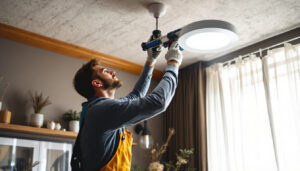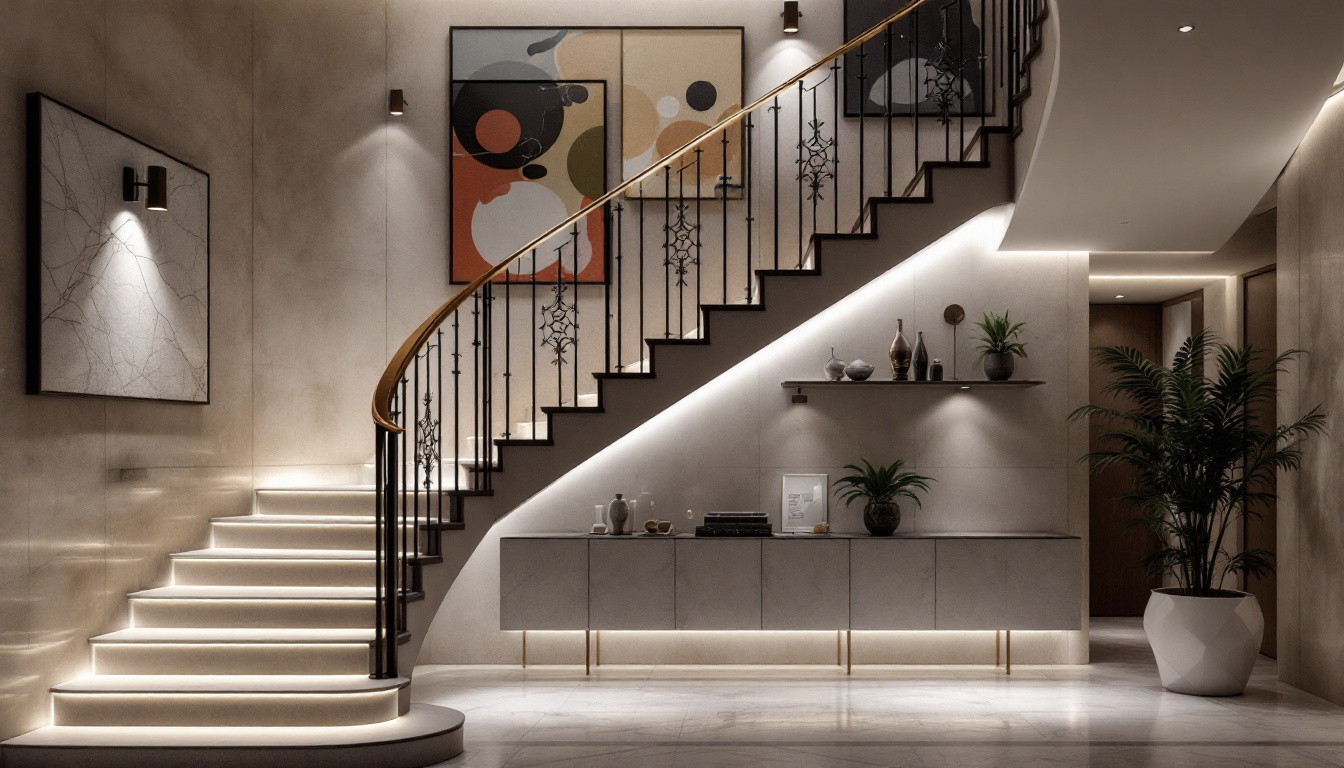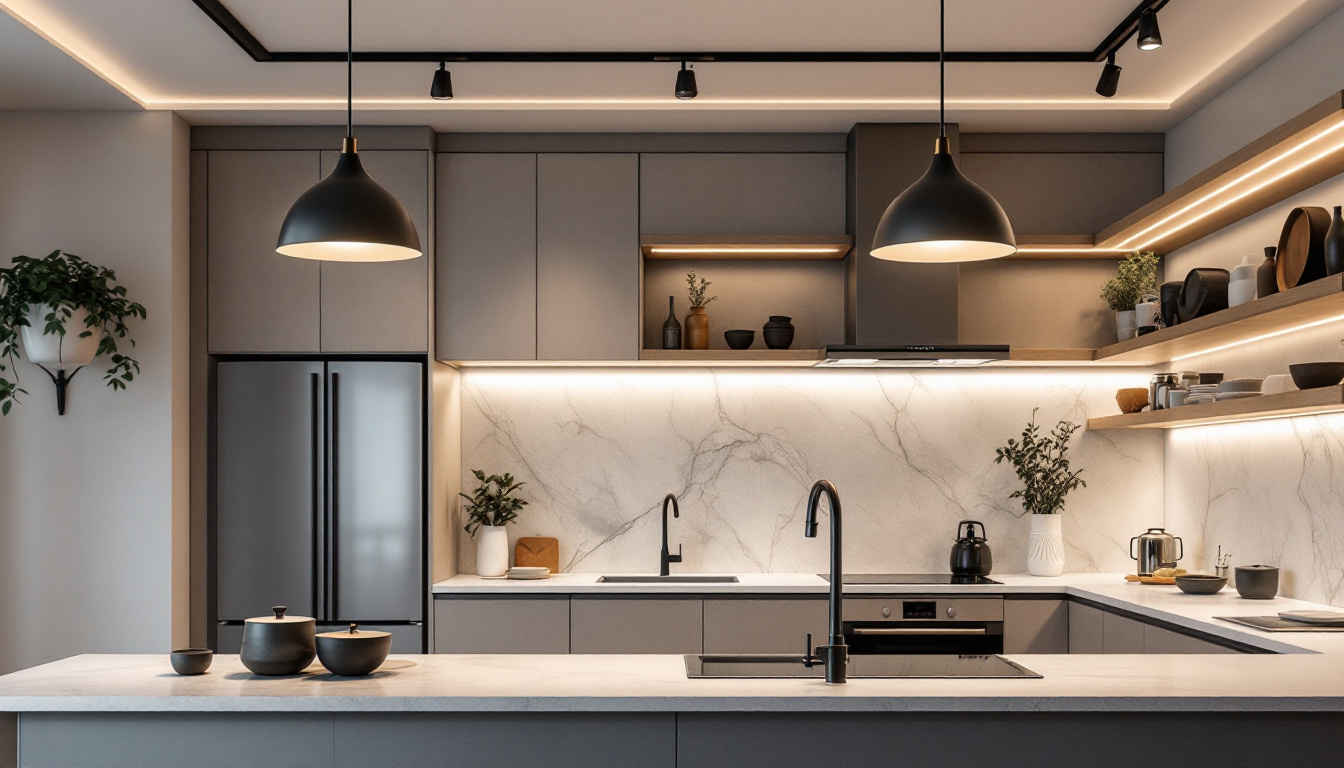

Staircase lighting has undergone significant transformation over the years, reflecting broader trends in the lighting industry. As both a functional necessity and a design element, staircase lighting has evolved to enhance safety, aesthetics, and energy efficiency. This article explores the journey of staircase lighting, examining its historical context, technological advancements, and current design trends that shape the industry today.
Understanding the evolution of staircase lighting begins with a look at its historical context. In earlier times, staircases were often illuminated using candles or gas lamps. These methods, while effective to some degree, posed safety risks and required constant maintenance. The flickering light of candles and the potential hazards of gas lamps made reliable illumination a challenge. In many households, the placement of these light sources was dictated by practicality rather than aesthetics, often resulting in poorly lit staircases that could be treacherous, particularly at night.
As electricity became more widespread, staircase lighting saw a significant shift. Electric bulbs offered a safer and more consistent source of light, allowing for innovative designs and placements. This transition not only improved visibility but also opened the door to creative expression in architectural design. With the advent of electric lighting, staircases transformed from mere functional spaces into dramatic focal points within homes and public buildings, showcasing the artistry of both the architect and the designer.
Initially, electric lighting in staircases was quite utilitarian. Simple bulb fixtures were installed to provide adequate illumination, often lacking in aesthetic appeal. However, as the technology progressed, so did the design possibilities. Decorative sconces and pendant lights began to emerge, adding character to staircases while fulfilling their primary function. These early electric solutions often featured intricate designs that reflected the architectural styles of their time, from Victorian elegance to Art Deco flair, allowing for a seamless integration of light fixtures into the overall design.
Architects and designers started to recognize the importance of lighting as an integral part of the overall design scheme. The interplay of light and shadow became a focal point in staircase design, leading to more sophisticated and visually appealing solutions. This newfound appreciation for lighting led to the incorporation of dimmers and multiple light sources, creating dynamic environments that could be adjusted for different moods and occasions. Moreover, the introduction of materials such as glass and metal in light fixture design not only enhanced the aesthetic appeal but also allowed for more creative expressions of style, making staircases not just a means of transition but a canvas for artistic illumination.
The advent of new technologies has played a crucial role in the evolution of staircase lighting. From the introduction of LED technology to smart lighting systems, these advancements have transformed how lighting is approached in residential and commercial spaces alike.
LED lighting has revolutionized the industry, offering energy efficiency, longevity, and versatility. Unlike traditional incandescent bulbs, LEDs consume significantly less energy and have a much longer lifespan, making them an economical choice for staircase lighting. This shift has allowed homeowners and contractors to invest in more elaborate lighting designs without the burden of high energy costs.
Moreover, LEDs come in various colors and intensities, enabling designers to create customized lighting solutions that enhance the aesthetic appeal of staircases. The ability to adjust color temperatures can evoke different moods, from warm and inviting to cool and modern. Additionally, the compact size of LED fixtures allows for innovative installations, such as recessed lighting within the staircase itself or under-step illumination, which can create a stunning visual effect while ensuring safety.
In recent years, the integration of smart technology into lighting systems has gained traction. Smart staircase lighting allows for remote control, automation, and customization, providing users with unprecedented flexibility. Homeowners can program their lighting to respond to their daily routines, enhancing convenience and energy efficiency.
Additionally, smart lighting systems can be integrated with motion sensors, ensuring that lights activate when someone approaches the staircase. This not only improves safety but also contributes to energy savings by reducing unnecessary usage. Furthermore, many smart lighting solutions offer compatibility with home automation systems, allowing users to control their staircase lighting through voice commands or smartphone apps. This level of control can enhance not only the functionality of the space but also the overall user experience, making it easier to create the perfect ambiance for any occasion, whether it’s a cozy family gathering or an elegant evening event.
As the lighting industry continues to evolve, so do the design trends influencing staircase lighting. Today, the focus is on creating visually striking and functional lighting solutions that enhance the overall ambiance of a space.
Minimalism has become a prominent trend in interior design, and staircase lighting is no exception. Clean lines, simple fixtures, and unobtrusive installations are favored to create a streamlined look. Recessed lighting and hidden fixtures are popular choices, allowing the architecture of the staircase to take center stage while providing necessary illumination.
This minimalist approach not only enhances the visual appeal but also contributes to a sense of spaciousness, making staircases feel more open and inviting. The focus is on subtlety, with lighting serving as an accent rather than a distraction. Furthermore, the use of dimmable LED lights allows for customizable brightness levels, enabling homeowners to adjust the mood according to the time of day or occasion, thereby enhancing the overall experience of the space.
Conversely, some designers are opting for bold, statement-making fixtures that serve as focal points within the staircase design. Chandeliers, oversized pendants, and artistic sconces can transform a simple staircase into a stunning visual centerpiece. These fixtures often combine form and function, providing ample light while also making a strong design statement.
Incorporating unique materials, such as glass, metal, or even organic elements, adds to the character of the staircase. This trend allows homeowners to express their personal style while ensuring that the lighting remains a key element of the overall design. Additionally, the interplay of light and shadow created by these striking fixtures can add depth and dimension to the staircase, creating a dynamic visual experience that changes throughout the day. Many designers are also experimenting with color temperature, using warmer tones to evoke a cozy atmosphere or cooler tones for a more modern, crisp feel, further enhancing the staircase’s aesthetic appeal.
While aesthetics are important, the primary purpose of staircase lighting remains safety. Proper illumination is essential to prevent accidents and ensure that users can navigate stairs with confidence. This section explores how safety considerations influence lighting design.
Effective staircase lighting requires careful consideration of illumination levels and fixture placement. Ideally, the entire staircase should be evenly lit, with no dark spots that could pose a risk. This often involves a combination of overhead lighting, wall sconces, and step lights to create a balanced lighting scheme.
Contractors must also consider the height and angle of fixtures to ensure that light is directed where it is needed most. Strategically placed lights can highlight the edges of steps, making them more visible and reducing the risk of slips and falls.
In commercial settings, emergency lighting is a critical aspect of staircase design. Ensuring that staircases are equipped with backup lighting systems can be a lifesaver in the event of a power outage or emergency. These systems often include battery-operated lights that automatically activate when the main power supply is interrupted.
Incorporating emergency lighting not only meets safety regulations but also provides peace of mind for building occupants. It is essential for contractors to stay informed about local codes and regulations regarding emergency lighting to ensure compliance and enhance safety.
As technology continues to advance, the future of staircase lighting looks promising. Innovations in energy efficiency, design, and functionality are expected to shape the industry for years to come.
With growing awareness of environmental issues, sustainable lighting solutions are becoming increasingly important. The use of energy-efficient LEDs is just the beginning; manufacturers are exploring eco-friendly materials and production methods to create lighting fixtures that have a minimal environmental impact.
Additionally, the integration of solar-powered lighting systems is gaining traction. These systems harness natural sunlight to illuminate outdoor staircases, reducing reliance on grid power and promoting sustainability.
The rise of smart home technology is set to further influence staircase lighting. As more homeowners adopt smart home systems, the demand for integrated lighting solutions will grow. Staircase lighting that can be controlled through voice commands, mobile apps, or home automation systems will become increasingly popular.
This integration not only enhances convenience but also allows for personalized lighting experiences. Homeowners will have the ability to create custom lighting scenes that cater to different activities, whether it’s a cozy evening at home or a lively gathering with friends.
The evolution of staircase lighting reflects broader trends in the lighting industry, showcasing a journey from basic functionality to sophisticated design and technology integration. As lighting contractors navigate this changing landscape, understanding the historical context, technological advancements, and current design trends will be essential for creating effective and aesthetically pleasing staircase lighting solutions.
With a focus on safety, sustainability, and innovation, the future of staircase lighting promises to be as dynamic as the industry itself. By embracing these changes, lighting professionals can continue to elevate the standard of staircase illumination, ensuring that it meets the needs of modern homeowners while enhancing the beauty of architectural spaces.
Ready to take your staircase lighting projects to the next level? At LumenWholesale, we provide lighting contractors with the finest spec-grade lighting products at prices that can’t be beaten. Our commitment to quality and affordability ensures that you can create stunning, safe, and energy-efficient lighting designs without the extra costs. Say goodbye to local distributor markups and hello to a vast selection of premium lighting solutions with the convenience of free shipping. Elevate your lighting game and give your clients the best value by choosing Wholesale Lighting at the Best Value with LumenWholesale.

Discover effective strategies for training your team in lighting with “Plug In With Switch.” This article delves into innovative techniques and tools to enhance your team’s skills, ensuring they are well-equipped to illuminate any project with expertise and creativity..

Explore the transformative journey of staircase lighting, from traditional designs to cutting-edge innovations.

Discover the transformative potential of LED light strips in modern lighting design.

Discover essential insights for lighting contractors on choosing and installing kitchen ceiling lights.
Get notified when NEW deals are released.
Optimize your budget with wholesale discounts.
Only top-quality, specification-grade lighting products.
No additional costs at checkout - what you see is what you pay.
We understand the unique needs of contractors.